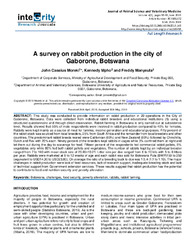| dc.contributor.author | Moreki, John Cassius | |
| dc.contributor.author | Mpho, Kennedy | |
| dc.contributor.author | Manyeula, Freddy | |
| dc.date.accessioned | 2021-04-13T07:44:04Z | |
| dc.date.available | 2021-04-13T07:44:04Z | |
| dc.date.issued | 2019-05-30 | |
| dc.identifier.citation | Moreki, J. C., Mpho, K., & Manyeula, F. (2019). A survey on rabbit production in the city of Gaborone, Botswana. Journal of Animal Science and Veterinary Medicine, 4(3), 90-99. | en_US |
| dc.identifier.issn | 2536-7099 | |
| dc.identifier.uri | https://integrityresjournals.org/journal/JASVM/article-abstract/9C4B91A72 | |
| dc.identifier.uri | http://researchhub.buan.ac.bw:80/handle/123456789/37 | |
| dc.description.abstract | This study was conducted to provide information on rabbit production in 20 operations in the City of Gaborone, Botswana. Data were collected from individual rabbit breeders and educational institutions (5) using a structured questionnaire and through direct observation. Rabbit farming in Botswana is only carried out at subsistence level. Results showed that 55% of male respondents were involved in rabbit production compared to 45% for females. Rabbits were kept mainly as a source of meat for families, income generation and educational purposes. Fifty percent of the rabbit stock was sourced from local breeders, 25% from South Africa and the remainder from local breeders and other countries. The predominant rabbit breeds reared were Californian (60%) and New Zealand (60%) followed by Chinchilla, Dutch and Rex with 20% each. Ninety percent of the breeders kept rabbits in cages while 3% confined them at night and let them out during the day to scavenge for feed. Fifteen percent of the respondents fed commercial rabbit pellets, 5% vegetables only while 80% fed both rabbit pellets and vegetables. The number of rabbits kept by an individual breeder ranged from 7 to 140 with mean stock size of 20.85±13.21. Litter size per doe ranged from 6 to 10 kits with 5 to 6 litters per year. Rabbits were marketed at 8 to 12 weeks of age and each rabbit was sold for Botswana Pula (BWP)150 to 250 (equivalent to USD14.30 to USD23.80). On average the ratio of a breeding buck to doe was 1:5.4 (1:1 to 1:10). The major challenges in rabbit production were lack of feed resources, lack of research support, inadequate breeding stock and lack of technical support from Government extension services. These results suggest that rabbit production has the potential to contribute to food and nutrition security and poverty alleviation. | en_US |
| dc.language.iso | en | en_US |
| dc.publisher | Intergrity Research Journals | en_US |
| dc.subject | Botswana | en_US |
| dc.subject | Challenges | en_US |
| dc.subject | Food security | en_US |
| dc.subject | Poverty alleviation | en_US |
| dc.subject | Rabbits | en_US |
| dc.subject | Rabbit farming | en_US |
| dc.title | A survey on rabbit production in the city of Gaborone, Botswana | en_US |
| dc.type | Article | en_US |

